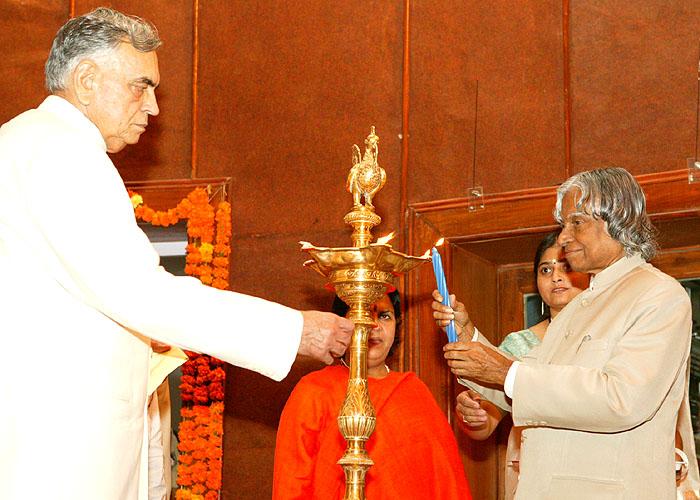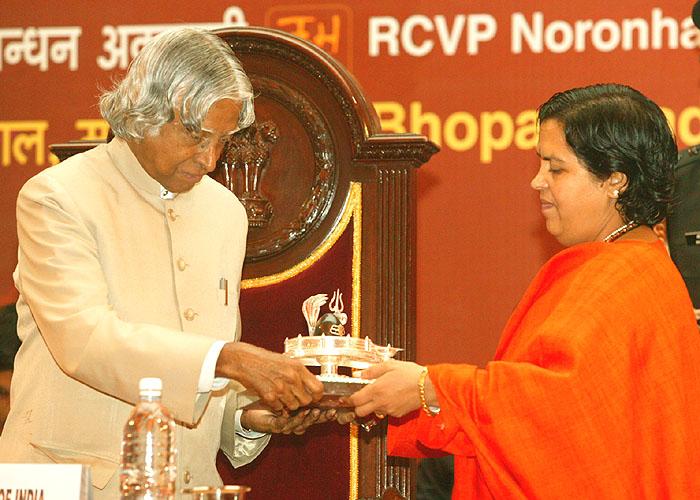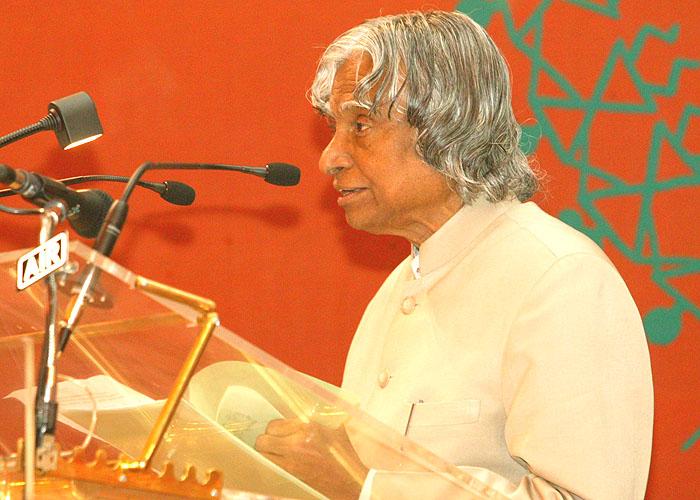Address At The Seminar On Alternative Strategies Of Development, Rcvp Noronha Academy Of Administration And Management, Bhopal
Bhopal : 10-08-2004
A Development Model
I am delighted to participate in the Seminar on Alternative Strategies of Development organized by the RCVP Noronha Academy of Administration and Management. I greet the organizers, participants, scientists and technologists, development managers and distinguished guests. I would like to discuss with this audience my thoughts on development through alternative strategies.
Rural Prosperity through connectivities
Nearly 700 million people of India live in the rural areas in 600,000 villages. Connectivity of village complexes providing economic opportunities to all segments of people is an urgent need to bridge the rural-urban divide, generate employment and enhance rural prosperity. Repeating what we did before for several decades with more of the same may not be the way to proceed further. We need to innovate to increase connectivities to the villages making clusters out of them even while retaining their individualities. When we discussed with the Members of Parliament from Madhya Pradesh and my interaction with the people in rural areas during my visits, our focus was to study the core competencies of the state, natural resources and the human power and how they can be combined to increase the earning capacity of the state. The state has taken tremendous initiative for physical connectivity and primary education. It is one of the first few states to have created its science and technology council and always been progressive to look at S&T as a vehicle for the prosperity for the community.
Essential Connectivities
The integrated methods which will bring prosperity to rural India are: the physical connectivity of the village clusters through quality roads and transport; electronic connectivity through tele-communication with high bandwidth fiber optic cables reaching the rural areas and broadband wireless; knowledge connectivity through education, skill training for farmers, artisans and craftsmen and entrepreneurship programmes. These three connectivities will lead to economic connectivity through starting of enterprises with the help of banks, micro credits and marketing of the products. The integrated method envisages a mission mode empowered management structure with executive powers at the local implementation levels and by reducing the transactional costs through simplification of procedures of governance.
Engines for growth
Emphasis should be on full utilization of natural and human resources to meet the demands of the modern society. We should also remember that about 50% of our population are young people with aspirations for better living. Value addition to agriculture, manufacturing and service sectors, building the regions? core competence and technologies will lead to additional high income employment potential. The engines for growth will be launching of the five national missions viz. water, energy, education and skills, infrastructure and employment generation, that will enable achievement of 10% GDP growth rate per annum which has to be sustained for a minimum period of ten years.
Development strategy
I have been studying the unsustainability of conventional growth strategies in relation to population, food production, industrialization, pollution and consumption of non-renewable natural resources. The alternatives for this would be to develop our villages using the native strength. One of the methods for containing pollution would be through Green buildings. Second would be to use renewable energy sources as the prime energy source for all activities of the village. One of the sources, which are abundantly available in the country, is solar energy. The third one will be conversion of municipal waste into electrical energy, which will solve the problem of pollution and also become a sustainable source of energy generation. The fourth one would be to have a Bio-diesel plant using Jatropha grown in dry and waste land. Jatropha is renewable and abundant source of bio-diesel.
I would like to discuss some of these strategies and the management systems needed for implementing these schemes in our rural cluster in partnership with private and public industries, NGO?s, R&D organisations, academic institutions and other management institutions.
Technology is a double-edged sword. The choice of technology should be such that it has little or no impact on the environment, maximize the utilization of local resources and is inclusive by taking everyone in the region as a stake holders.
My Experience with Green Buildings
Recently, I saw a huge multipurpose complex, at Hyderabad, which has been awarded platinum rating. This is the third building to be awarded platinum rating by Leadership in Energy and Environment Design (LEED) and the first building outside the United States. I had visited and seen around the green building. Wherever I went, there was day light coming in, an automatically controlled light, water and cooling system is in place through the natural energy saving design of the green building. I had witnessed the rooftop designed in a successively sloping fashion to conserve the heat energy as well as to generate solar power with solar panels for the Green building. Reusing the building materials and prefabricated bricks are the unique features. I was told that it enables 30% to 40% reduction in annual operational cost of the buildings; but approximately 25% increase in the building cost for the Green building. Even though the Green building concept is at a nascent stage in India, CII is assisting seven corporates in constructing green buildings. The overall potential for green building materials and equipment is expected to be about Rs. 22,000 crores by 2010. Few green materials and equipments are already available in the country.
Majority of water used in Green buildings is recycled. The fresh water consumption in green buildings is about 30% lower than conventional buildings. In addition Green buildings can lead to higher employee productivity, higher utilization of recycled materials, higher focus on landscapes and cleaner/greener environment.
Similarly, solar cooking, solar heating and windmills are also finding application in large, medium and small buildings as an energy saving mechanism. These energy saving, pollution free, water conserving, cost effective features are necessary to be incorporated in all our Government buildings - technical and administrative, housing complexes, community centers, schools, educational institutions and hostels. Next I would like to discuss about power mission.
Power mission
So far our generating capacity is one-lakh mega watts of power. For meeting the development targets till 2020 our generating capacity has to increase to three lakhs mega watts. This additional power has to come from nuclear energy, hydroelectric systems, renewable energy and thermal energy. The contribution from the renewable energy especially from solar energy and wind energy has to be increased to one hundred thousand mega watts. Urgent measures are needed to reduce the distribution loss to less than 5% from the existing 25%.
Solar Energy
Unreliable supply, high cost of electricity, and availability at night time has also been affecting the productivity and profitability of the farmers. With increasing demand for energy and increasing oil prices the problem is going to be more serious in the future. Installation of centralized solar photovoltaic systems, which can be fed to a grid, will be a long-term economically viable solution with added benefits of pollution control. We should build many 100 mega watt solar power stations capable of meeting the needs of the farmers with minimum maintenance expenditure.
Municipal waste ? a case study
Increased urbanization, have led to a serious problem of accumulation of municipal municpal waste in many towns and cities. Efficient and environmentally clean disposal of garbage has always been a major technological challenge. While being a threat to the environment, mounting garbage is also a rich source of energy. The potential for converting this waste into useable energy, which will eliminate a major source of urban pollution, was realized by one of our innovative organizations- Technology Information Forecasting and Assessment Council (TIFAC) of DST, which helped in developing a completely indigenous solution for the processing of waste into a source of fuel. This fuel could, in turn, be used for generation of electricity through mini plants. Already in our country two plants which generate 6.5 mega watt power using the municipal waste bricks are in operation. India needs thousands of mini power plants using municipal waste. This can be a mission of corporate houses, small-scale industries and social upliftment organizations. This can be replicated in many of our cities and village clusters as an infrastructure build-up project. This project apart from being an employment generator will provide a clean environment for the people to live in.
Balancing Generation and use
I should also point out that actions do not stop at increasing generation alone. It has to be of good quality. No voltage fluctuation or frequency variations should be there. In addition, transmission and distribution has to be efficient with low loss. Above all at the consumer end energy efficiency should be the key word. We generate power for good use and not to be wasted as useless heat or sound. The lesser we use energy more kind we are with the environment. Therefore, for each watt used we should get maximum end use.
Now I would like to discuss in detail about sustainable production of bio-diesel, which is also an employment generator.
Biodiesel - Jatropha
We have nearly 63 million hectares of wasteland available in the country, out of which 33 million hectares of wasteland have been allotted for tree plantation. Certain multi-purpose trees such as Jatropha can grow well in wasteland with very little input. Once grown the crop has a fifty years of life. Fruiting can take place in this plant in two years. It yields upto five tonnes per hectares oil seeds and produces two tones of bio-diesel. Presently, the cost of bio-diesel through the plant is approximately Rs. 17 to Rs. 19 per liter which can be substantially reduced through choice of right size of the plant and using high yield variety plantation which has already been established by the researchers. Bio-diesel plants grown in 11 million hectares of land can yield a revenue of approximately Rs. 20,000 crore a year and provide employment to over 12 million people both for plantation and running of the extraction plants. This is a sustainable development process leading to large scale employment of rural manpower. Also, it will reduce the foreign exchange outflow paid for importing crude oil, the cost of which is continuously rising in the international market. Use of Bio-diesel is Carbon mono-oxide emission free. This oil can also be used for soap and candle industries. De-oiled cake is a raw material for composting and plantation is good for honey production. We should absorb best of the technologies available worldwide and start commercial operation soon, instead of staying at pilot plant levels. So far we have discussed about the power and the sustainable energy generation missions. Now I would like to touch upon the water management system for sustainability.
Water mission
Water is an essential requirement and the key to our lives. It is essential to provide clean potable drinking water to all the people of the nation. Water is required for irrigation, industries, power generation and environmental protection. The availability of water varies from place to place depending upon the climatic conditions. For ensuring continued availability of water, we need an effective water management and distribution system.
Water harvesting and recycling
Water harvesting should become mandatory for all. To improve water table we need to build check dams; develop water sheds, desilt ponds and rivers, clear the inlets and outlets to the ponds and water bodies and recharge the wells. If our rural areas are made to have the operational water bodies, recharging of the wells will take place automatically. These activities will also generate employment.
Flood control
There are certain regions in the country, particularly Bihar and Assam, which are constantly affected by floods every year. We are witnessing the situation even now. There is an urgent need to find long-term solution to control flood, store and utilize the surplus water during drought. In the Gangetic plain, I would recommend construction of layered wells in the entry points of Kosi river from Nepal. These layered wells will store the floodwater at different levels and will control the devastating effects on low-lying areas. The water thus stored will be useful during shortage period. Similar solution can be found for the other regions.
Now I would like to suggest a management structure for the agricultural, production, processing and marketing which will enable the sustainable development of the rural areas.
Co-operative Structure for Agri-Production-Processing-Marketing:
I would now like to discuss a co-operative structure, which can be created for promoting the interest of the farmers.
The essential features would be:
a. Create a co-operative in major centers involving Government, NGOs, Consultancy Services, R&D Organisations and people as partners.
b. Farmers will provide land and labour and will be partners in profit.
c. The NGOs and Consultants will identify the opportunity, draw the business plan, organize value addition and marketing.
d. R&D Organisations will provide knowledge inputs for quality agricultural products and technology transfer including training.
e. The co-operative will provide finance, critical inputs, critical infrastructure, crop insurance and technical guidance such as arrival of monsoon, combating drought etc. to the farmers.
f. The co-operative will be responsible for preservation, diversification, quality assurance, transportation, marketing and profitable operation of the overall business.
g. The Government will provide policy framework for the smooth transparent operation of the co-operative on the lines of the Amul model for safeguarding the interest of the farmers and other stakeholders. There is also a need to avoid the problems faced by many cooperatives due to non-professional management.
Employment Generation through entrepreneurship
All the above ingredients of development namely assured water, assured energy supplies, assured food, assured connectivities for commerce and education, have implicitly embedded in them the goal of generating viable employments for all segments of the society. In addition, the establishment of good physical and electronic connectivity makes it easier to develop skill sets on demand through tele-education on a just-in time basis.
Development Partners: Industries, Banks and Universities
Firstly, the educational system should highlight the importance of entrepreneurship and prepare the students right from the college education to get oriented towards setting up of the small scale industrial enterprises and any ventures in our rural areas which will provide them creativity, freedom and ability to generate wealth. Apart from entrepreneurship, the youth should have the spirit that ?we can do it?. Secondly, the banking system should provide venture capital right from every village level to the prospective entrepreneurs for undertaking new enterprises. Banks have to be proactive to support the innovative products for enabling wealth generation by young entrepreneurs by setting aside the ?conventional tangible asset syndrome?. Definitely this involves certain amount of calculated risks, which can be eliminated by making an analysis of successful venture capital enterprises. Thirdly, there is a need to identify marketable products and enhancement of purchasing power among the people.
Conclusion
Recent experiences indicate that the economic progress of a few countries particularly the developed countries is due to the contribution of large number of small entrepreneurs employing less than 50 persons in their establishments. We need such entrepreneurs in large numbers in our country for developing and transforming our village clusters into sustainable economic units. I am sure many of the entrepreneurs and managers grown by this ?RCVP-Noronha Academy of Administration and Management?, will create enterprises in many PURA complexes in the country, particularly in Madhya Pradesh, in the coming years, improve the lifestyle of our village community and be an active partner in Developed India mission. Let us join together in building India as a developed nation and get the rightful place for India in this planet.
My best wishes to all of you.
Documents



